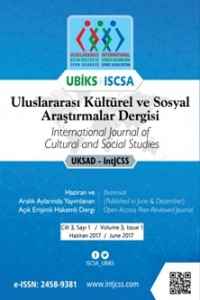Determination of Information Technology Strategic Operation on Health Insurance Brand in Kermanshah State
Abstract
The aim of this study was to
evaluate the effectiveness of the implementation of strategic IT Kermanshah
Province on brand of health insurance. This study is an applied research in
terms of aims and is a descriptive study in terms of methodology and from
correlation of data collection method is a quantitative method. The population
includes all Health insurance users and employers in Kermanshah during 2015
that are 120 people and all customers of this insurance that because of
unavailability considered as infinite. Static sample
according to population and using Morgan and Korjesi table determined 92
employers and 384 customers.
Measuring instruments and IT strategy, IT inventory Davis from
Sheikhshahi and Olomi Research (2007), and means of measuring brand image,
Kampdrsad questionnaire (2001) respectively. Statistical methods included descriptive
statistics and inferential statistics (Kolmogorov - Smirnov test, Pearson
correlation and regression). The results showed that the strategic impact of
information technology on brand image. The perceived usefulness, ease of
understanding, attitude towards information technology and use of technology
are improving brand image. The component easy to understand has the greatest
impact on brand image.
References
- Bonenr, C. (2007). Image is All: Deregulation. Restructuring and Reputation in the Natural Gas Industry, American Gas.
- Faircloth, J. (2005). Factors Influence Nonprofit Resource provider Support Decisions, Applying the Brand Equity Concept to Nonprofits, Journal of Marketing Theory and practice, 5(2), 87-99.
- Gregory, J. (1991). Marketing Corporate Image. Chieago, NTC Business Books.
- Leone, R. P., Roa, V. R., Keller, K. L., & Luo, A. M. (2006). Linking brand equity to customer equity. Journal of Service Reasserch,90(2), 125-138.
- Larson, L. L. (2004). Internal auditors and job stress. Managerial Auditing Journal, 19(9) 1119-1130.
- Martenson, R. (2007). Corporate Brand Image Satisfaction and Store Loyalty. International Journal of Retail & Distribution Management, 35, 129-139.
- Moffit, M. A. (1994). A Cultural Studies perspective to w ard Understanding Corporate Image;A Case study of State Farm Insurance. Journal of public Relations Research, 6(2), 42-49.
- Oh Mi, Y. (2000). South Korean Attitudes toward foreign Subsidiaries of Multinational Corporations (MNCS): The Halfpence of Corporate Image and Country of Origin Image and the presence of Halo Effect, Southern Illinois University.
- Rasoulipashte, B., Bagherinejad, J. (2010). The effect of information technology investment on customer satisfaction. Technology development, 6 (22), 55-64.
- Sarafizade, A. (2007). Management information systems. Tehran: Termeh
- Taghirzade, I. (2006).The effect of IT systems on the effectiveness of the organization "Organization of Libraries, Museums and Documents Center of Astan Quds Razavi." MA thesis, Tehran, Shahid Beheshti University
- Tallon, P. P. (2007). Does IT Pay to focus? An analysis of IT business value under single and multe-foucused Business Strategies: Journal of Strategic Information for Quality Management, 5(1), 69-83.
- Venable, B. T. G., Rose., M., & Gilbert, W. (2003). Measuring the Brand personality of Nonprofit Organizations. Advance in Consumer Research, Consumer Research,30(1), 77-89.
- Yang, Z., & Jun, M. (2002). Consumer perception of service–quality: from Internet purchaser and non purchaser perspectives. Journal of Business Strategy, 19, 19-41.
- Zain, M. R. (2009). The relationship between information technology acceptance and Image of Organization in Malaysia, Information and Management,42(1), 829–839.
Abstract
References
- Bonenr, C. (2007). Image is All: Deregulation. Restructuring and Reputation in the Natural Gas Industry, American Gas.
- Faircloth, J. (2005). Factors Influence Nonprofit Resource provider Support Decisions, Applying the Brand Equity Concept to Nonprofits, Journal of Marketing Theory and practice, 5(2), 87-99.
- Gregory, J. (1991). Marketing Corporate Image. Chieago, NTC Business Books.
- Leone, R. P., Roa, V. R., Keller, K. L., & Luo, A. M. (2006). Linking brand equity to customer equity. Journal of Service Reasserch,90(2), 125-138.
- Larson, L. L. (2004). Internal auditors and job stress. Managerial Auditing Journal, 19(9) 1119-1130.
- Martenson, R. (2007). Corporate Brand Image Satisfaction and Store Loyalty. International Journal of Retail & Distribution Management, 35, 129-139.
- Moffit, M. A. (1994). A Cultural Studies perspective to w ard Understanding Corporate Image;A Case study of State Farm Insurance. Journal of public Relations Research, 6(2), 42-49.
- Oh Mi, Y. (2000). South Korean Attitudes toward foreign Subsidiaries of Multinational Corporations (MNCS): The Halfpence of Corporate Image and Country of Origin Image and the presence of Halo Effect, Southern Illinois University.
- Rasoulipashte, B., Bagherinejad, J. (2010). The effect of information technology investment on customer satisfaction. Technology development, 6 (22), 55-64.
- Sarafizade, A. (2007). Management information systems. Tehran: Termeh
- Taghirzade, I. (2006).The effect of IT systems on the effectiveness of the organization "Organization of Libraries, Museums and Documents Center of Astan Quds Razavi." MA thesis, Tehran, Shahid Beheshti University
- Tallon, P. P. (2007). Does IT Pay to focus? An analysis of IT business value under single and multe-foucused Business Strategies: Journal of Strategic Information for Quality Management, 5(1), 69-83.
- Venable, B. T. G., Rose., M., & Gilbert, W. (2003). Measuring the Brand personality of Nonprofit Organizations. Advance in Consumer Research, Consumer Research,30(1), 77-89.
- Yang, Z., & Jun, M. (2002). Consumer perception of service–quality: from Internet purchaser and non purchaser perspectives. Journal of Business Strategy, 19, 19-41.
- Zain, M. R. (2009). The relationship between information technology acceptance and Image of Organization in Malaysia, Information and Management,42(1), 829–839.
Details
| Journal Section | Research |
|---|---|
| Authors | |
| Publication Date | June 30, 2017 |
| Submission Date | September 2, 2017 |
| Acceptance Date | June 8, 2017 |
| Published in Issue | Year 2017 Volume: 3 Issue: 1 |
International Journal of Cultural and Social Studies

